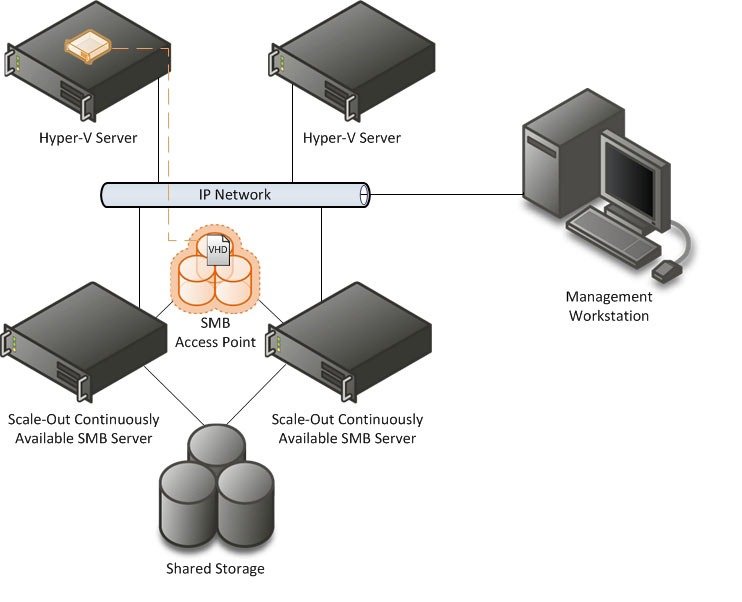This post is also available in: Italian
Reading Time: 5 minutesMicrosoft is an historical name in the IT world, both in the consumer and the professional area.
Actually it’s already a player in the storage world: just consider the Windows Storage Server edition included in some storage appliances (for example the Dell PowerVault NX family). But Windows Storage Server is little more than an “embedded” version of Windows Server and basically is just a dedicated Windows Server (with a better license cost than the full edition).
An enterprise storage is just more than this and must provide more functions, but first to all an high availability configuration (and possibly also a scalable solution).
Starting with Windows Server 2012, Microsoft has introduced lot of storage related features including SMB3, de-duplication, a new filesystem for huge volumes (ReFS) and storage spaces. And with Windows Server 2012 R2 also a multi-tiering. Actually Storage Spaces with Tiering is something really close and comparable with enterprise storages and Windows Server could be (loosely) presented as a Software Defined Storage solution.
For sure is a unified storage solution, because it can provide block level (with the included iSCSI Target) and NAS access (both NFS and SMB). But the most interesting solution is the Scale-Out File Server solution: a really scalable (with multi-active nodes) file server with SMB3 protocol. Considering that Hyper-V and SQL Server could run on this kind of solution it could be absolutely interesting in several scenarios.
 But there is (big) limit: you still need an hardware part to provided shared storage (in SAS JBOD mode). Actually there isn’t a redundantfeature across physical servers and the only way is share all the disks across all storage nodes. This make the solution less scalable (usually JBOD are for only two nodes, but the solutions itself could handle more nodes) but also less affective (server are really a COTS solution, but JBOD shelves?).
But there is (big) limit: you still need an hardware part to provided shared storage (in SAS JBOD mode). Actually there isn’t a redundantfeature across physical servers and the only way is share all the disks across all storage nodes. This make the solution less scalable (usually JBOD are for only two nodes, but the solutions itself could handle more nodes) but also less affective (server are really a COTS solution, but JBOD shelves?).
Of course you can use an existing SAN and use the Scale-Out File Server only as a “filer” gateway, but honestly I don’t see this solution so interesting: at this point why don’t use directly your SAN (there could be several answers, but the main question is why use a SAN if you can do all without it)? The Scale-Out File Server could become really interesting using “low cost” hardware components, and not using a costly SAN.
Certified storage solutions are actually limited and shared DAS are not useful: you don’t need a shared storage, you just need shared disks. Storage vendor of course has JBOD solutions but usually are used internally to provide the entire storage solution (for example the entire Dell Compellent system is composed by two servers with one or more shared JBOD shelves). Is not so easy buy a JBOD as a spare from a storage, or at least could be not so interesting in term of price.
The existing list of certified JBOD solutions is limited, but it isn’t really an official list: basically each JBOD solution with certified SAS card (in the server side) could work. So you use, for example, the Nexenta HCL you can found a more complete list of possible products (also Nexenta is a full software solution that rely on shared JBOD, in the high availability architecture).
In order to improve this list Microsoft could or should become also a storage vendor and build (or just re-brand) it’s JBOD solution? Maybe a four nodes JBOD system, that can make more interesting the overall solution.
Some weeks ago my thought was that this was the only move to do in order to build a complete solution: waiting for traditional hardware vendors was utopic because most of them were also storage vendor and sell a JBOD product could mean loose storage market share.
But recently something has changed: for example IBM has sells the server unit to Lenovo and Dell has announced to support Microsoft Storage Spaces. Dell also provide a complete architecture reference document on how Deploying Storage Spaces on PowerVault MD12XX systems.
So actually there is no need for Microsoft to become a hardware/software storage vendor: there are enough COTS products to build a complete (limited to two nodes) storage solutions based on Storage Spaces. Could be nice if JBOD with more than two nodes become available (for example the Dell PowerEdge VRTX could be perfect for build a scale-out file server, but actually there isn’t a Shared-SAS controller for this product).
Honestly I hope that in next version will be add some kind of network redundancy and replication features that will make Storage Spaces a modern and fully scale-out solution, independed by the hardware architecture.
To conclude this post, just a curios note: Microsoft it’s already also an hardware storage vendor. They are selling the StorSimple cloud-integrated storage solution.
StorSimple cloud-integrated storage provides primary storage, backup, archive, and disaster recovery, combined with Windows Azure. This allows you to optimize total storage costs and increase data protection and service agility. With StorSimple, you can integrate the public cloud with on-premises storage to reduce datacenter infrastructure complexity, maximize data protection, reduce overall storage total cost of ownership (TCO) by 60-80%, and provision storage more rapidly to reclaim IT time cycles.


